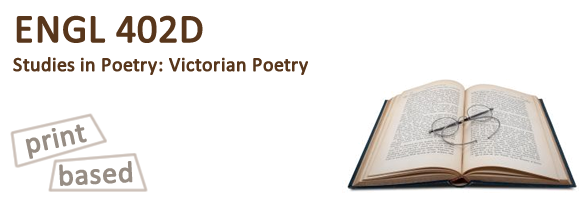
Mode of Delivery
This is a print-based, correspondence course.
Course Outline
- Five assignments
- Final examination
Course Description and Prerequisites
Tennyson, Browning, and Arnold. A few weeks are devoted to later poetry. The distance education version of English 402D offers a survey of Victorian poetry with special emphasis on genre and the work of Tennyson, Browning and Arnold. Attention is also given to Rossetti, Swinburne, Morris, Meredith, Hopkins and Clough. Prerequisites are six credits in first year English, or Arts One, or Foundations, and third-year standing.
Course Overview
English 402D, Victorian Poetry, is an introduction to the evolution of major forms of poetic expression during the years of Queen Victoria’s reign (1837-1901). While avoiding an author-by-author presentation, the course nonetheless provides an inter-related overview of the careers of individual poets by including a variety of works by the same poet. The presentation of the course is based on the concept that among the many possible approaches to the study of Victorian poetry–historical, biographical, social or chronological–one that concentrates on the literary development of specific forms would best reveal the diversity and energy of the writing. Hence, the focus on the elegy, sonnet, long poem, dramatic monologue, and satire, as well as poetic experiments, artists and the use of myth.
Preceding the concentration on form are discussions of the reception of Victorian poetry and the special nature of Victorian poetic language. The aim of the course, however, is not only to provide a detailed account of poetic forms fundamental to the Victorian poets but also to indicate why the major poets employed various literary styles to express their subjects. Tennyson, for example, wrote a major elegy, In Memoriam, a long poem, Idylls of the King, a dramatic monologue, “Ulysses,” and a mythic work, “The Lotus Eaters.” But the lessons that follow do not forfeit attention to theme since the success of a poetic form is often measured by its ability to state a theme. The result is an inter-related study of the major and minor poets of the era through the development of Victorian poetics.
Each lesson, other than the first two, focuses on a single poetic form but has a dual purpose: to develop an understanding of that form, and to demonstrate how Victorian poets employed it. Comparison as well as development highlight the method. The object of Lesson 5: The Long Poem, for example, is to examine the shape of the long poem in the Victorian period, why it became so popular with poets and readers alike, and what themes characterized its principal examples. The importance and use of narrative technique will also be considered, as well as parallels between the long poem and the novel. Supplementing the core texts for this lesson and others, will be secondary readings, occasionally included in the course manual.
Graded Assignments
There are five essay assignments of 1,200 words each for the course. The 1,200-word essay is roughly equivalent to four to five typed, double-spaced pages. A choice of essay topics accompanies those Lessons with a writing assignment–Lessons 2, 3, 5, 6, 9.
Grading and the Final Examination
For English 402D, the following values will be assigned to the papers and final examination:
| Five Assignments | 70% |
| Final Examination | 30% |
| Total | 100% |
Required Texts – Textbook Order Form
- Altick, R., Norton., Victorian People and Ideas. Norton, 1974.
- Houghton, W. and R. Stange, eds., Victorian Poetry and Poetics, 2nd ed. Houghton Mifflin, 1968.
Also required is:
- ENGL 402D Learner Package (includes course manual).
